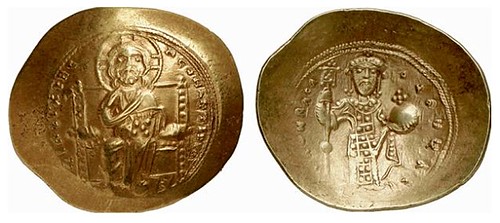
PREV ARTICLE
NEXT ARTICLE
FULL ISSUE
PREV FULL ISSUE
WHY ARE BYZANTINE COINS CUP-SHAPED?
While reading the CoinWeek article on the current craze for cup-shaped coins. I noticed a link to an article by Mike Markowitz on why Byzantine coins are cup-shaped. It's an excellent article; be sure to read the full version. Here's an excerpt.
-Editor

Deeply cupped Gold Histamenon Nomisma of Constantine IX 1059-1067 During the reign of emperor Michael IV (1034-1041), the gold coins became slightly concave. By the middle of the 12th century most of the coinage in all metals was deeply cupped. The reason for this bizarre transformation has baffled and intrigued generations of numismatists. In this article we review some of the theories and discover an explanation that makes sense, based on what we know about metallurgy and structural engineering. In the medieval world, rulers were strongly tempted to adulterate or “debase” the currency, to stretch a limited supply of precious metal to pay more soldiers, build another palace, or distribute more diplomatic bribes (oops, I meant “gifts!”) But debasing the coins undermined public confidence, contributed to inflation and created all sorts of technical problems for the mint. Gold (specific gravity 19.32) is much more dense than silver (specific gravity 10.49), for example. So if you want to hold the weight of a coin constant, mixing a higher proportion of silver into the gold will give you a bigger coin. Either it will become thicker (making it harder to strike), or it will be greater in diameter (requiring bigger dies to strike.) In the year 1000, the average diameter of the gold nomisma was about 23mm (0.9 inches). By 1085, the coin had the same thickness but measured about 31mm (1.22 inches) in diameter. All things being equal, a bigger coin is more impressive. The typical design bore a portrait of Christ on the convex (obverse) side, and the figure of the emperor on the concave (reverse) side. A large, thin coin is easily bent, and because a gold-silver alloy is more brittle than soft, pure gold, it’s also more likely to crack. It seems clear that the main reason for the emergence of the concave fabric, and its survival for almost three centuries, was to make thin coins strong enough to resist bending and breakage. When the fabric became too thin and the alloy was too brittle, edge cracks inevitably became a problem–something familiar to every collector of these difficult coins. Medieval technology was rarely documented; everything technical was treated as a “trade secret.” But the basic principles of metallurgy and engineering don’t change. In the cup-shaped Imperial coinage, we see how the mint masters of Constantinople creatively applied these principles to solve a complex technical, economic and political challenge.
The article also includes a great illustrated description of how cup-shaped coins must have been struck.
-Editor
To read the complete article, see: Why Did Byzantine Coins Become Cup-Shaped? (www.coinweek.com/featured-news/byzantine-coins-become-cup-shaped/) THE BOOK BAZARREWayne Homren, Editor The Numismatic Bibliomania Society is a non-profit organization promoting numismatic literature. See our web site at coinbooks.org. To submit items for publication in The E-Sylum, write to the Editor at this address: whomren@gmail.com To subscribe go to: https://my.binhost.com/lists/listinfo/esylum All Rights Reserved. NBS Home Page Contact the NBS webmaster 
|